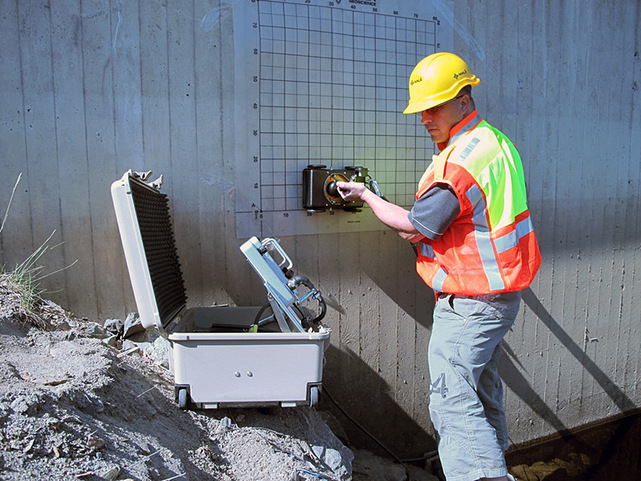Comprehensive Guide to Concrete Scanning Technologies
Wiki Article
Past the Surface Area: Leveraging Advanced Concrete Scanning Techniques for Unmatched Accuracy and Understanding
Advanced concrete scanning methods have actually arised as important tools in this pursuit, providing a glance below the surface area to unveil a world of essential insights. By utilizing advanced modern technologies, experts can uncover anomalies, assess the problem of concrete frameworks, and make informed choices that shape the course of projects.Importance of Advanced Concrete Scanning
The importance of making use of sophisticated concrete scanning strategies lies in the unequaled accuracy they use for discovering sub-surface anomalies and making sure structural honesty. By utilizing sophisticated innovations such as ground-penetrating radar (GPR), electromagnetic induction, and advanced sonar imaging, building professionals can delve below the surface area of concrete frameworks with a level of accuracy that far goes beyond standard assessment methods. Concrete Scanning. These strategies enable the identification of concealed threats like rebar corrosion, voids, channels, or post-tension cables that could jeopardize the stability and security of a structure in timeAdditionally, progressed concrete scanning gives important understandings into the total condition of a concrete element without the requirement for intrusive procedures, minimizing the threat of causing damage during the analysis process. The capacity to pinpoint the specific area and depth of prospective issues permits targeted repairs and upkeep, eventually lengthening the life expectancy of the framework and enhancing its efficiency. Basically, the value of advanced concrete scanning can not be overstated in the world of building and construction and facilities upkeep, where accuracy and dependability are paramount.
Sorts Of Cutting-Edge Technologies

Anomalies and Flaw Discovery

Along with GPR, concrete scanning strategies like thermography and impact-echo screening are also effective in discovering issues and abnormalities. Thermography utilizes infrared modern technology to determine variants in surface area temperature, showing prospective areas of problem such as delamination or wetness ingress. On the various other hand, impact-echo screening entails assessing acoustic feedbacks to detect gaps, splits, and other defects within the see this concrete. By leveraging these advanced techniques, professionals can proactively attend to structural issues, making sure the long life and safety and security of concrete structures.
Assessing Concrete Condition
Just how can designers properly examine the condition of concrete structures to guarantee their durability and security? Evaluating the concrete condition is an important aspect of maintaining infrastructure integrity. Various advanced concrete scanning techniques are used for this objective. Ground-penetrating radar (GPR) is frequently utilized to analyze the internal framework of concrete, finding voids, fractures, and various other abnormalities that may compromise its toughness. Additionally, impact-echo testing can provide insights right into the density and integrity of concrete aspects. Ultrasonic pulse rate screening is an additional useful approach for assessing concrete high quality by measuring the speed of acoustic waves through the product.Integrating non-destructive testing techniques with visual inspections enables for an extensive evaluation of concrete condition, allowing designers to determine possible problems early on and execute prompt maintenance or repair services. By leveraging these innovative strategies, designers can make sure the long-lasting toughness and safety and security of concrete frameworks.
Enhancing Decision-Making Processes
In the world of framework monitoring, enhancing decision-making procedures is essential for guaranteeing the reliable upkeep and longevity of concrete structures. Improved decision-making processes in concrete monitoring include using advanced scanning strategies to collect thorough information on the problem of structures. By leveraging technologies such as ground-penetrating radar and 3D imaging, stakeholders can make informed decisions relating to repair work, replacement, or reinforcement approaches.These progressed scanning strategies give invaluable insights right into the inner make-up of concrete, recognizing prospective problems such as voids, splits, or hop over to here rust that may not be noticeable externally. This level of detailed information permits positive maintenance planning, minimizing the danger of architectural failings and enhancing the general life-span of concrete frameworks.
Furthermore, by including digital documents and evaluation devices into the decision-making procedure, stakeholders can track the advancement of concrete conditions in time, enabling predictive maintenance strategies and optimizing source allowance. Inevitably, the assimilation of innovative concrete scanning strategies boosts decision-making processes by offering unequaled precision, understanding, and efficiency in infrastructure monitoring.
Conclusion
In verdict, progressed concrete scanning strategies offer unmatched accuracy and understanding in identifying anomalies, problems, and examining the problem of concrete frameworks. By leveraging advanced innovations, decision-making procedures can be improved, bring about more efficient and informed options for maintaining and repairing concrete facilities. These methods play a critical duty in guaranteeing the safety and long life of concrete frameworks, making them an indispensable tool in the field of building and design.Furthermore, progressed concrete scanning provides invaluable insights into the total condition of a concrete element without the need for invasive procedures, reducing the risk of creating damage throughout the analysis procedure - Concrete Scanning. An additional cutting-edge technology is 3D X-ray scanning, which supplies thorough photos of the inner structure of concrete, using valuable details without the demand for damaging screening. In Addition, Concrete Cover Meters are made use of to gauge the thickness of concrete cover over reinforcement bars properly. Boosted decision-making processes in concrete administration include utilizing click advanced scanning techniques to collect thorough information on the problem of frameworks.In conclusion, advanced concrete scanning methods provide unparalleled precision and insight in spotting anomalies, flaws, and evaluating the condition of concrete structures
Report this wiki page